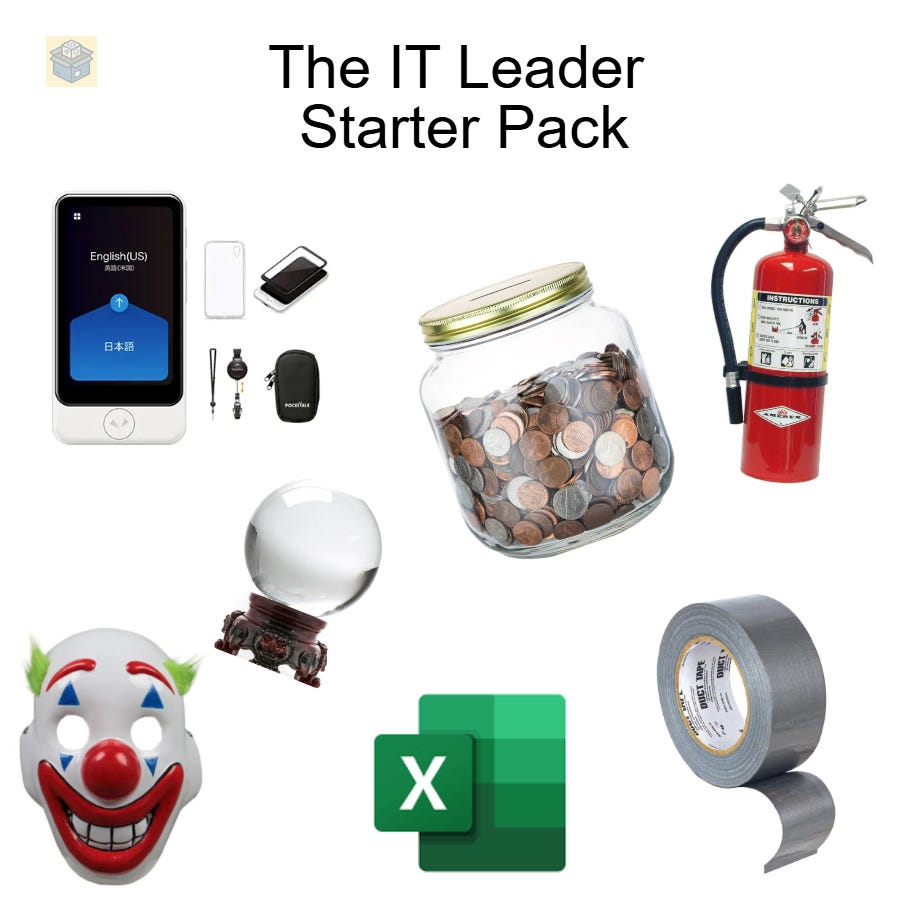Start Here: Navigating IT Leadership in B2B M&D
Making IT work in an industry where change moves at forklift speeds.
Welcome.
If you’re an IT leader in manufacturing or distribution, you’ve probably realized that the playbooks written for Silicon Valley don’t quite apply to your world. Mid-market and enterprise manufacturers and distributors have unique challenges. Legacy systems, complex supply chains, fragmented data, and a business culture that’s skeptical of technology investments.
This Substack is for CIOs, VPs of IT, IT Directors, Digital Leaders, or those who are aspiring to be one. If you’re a functional leader outside of IT, maybe it will help you understand the disposition of your peer better too.
Here you’ll find practical insights on how to modernize, align IT with business strategy, and ultimately drive value beyond keeping the lights on.
I’ve been in your shoes and seen some stuff, so to speak. If you’ve ever had to explain to your CEO why a 25-year-old ERP won’t support AI, or if you've spent a year trying to integrate a new eCommerce platform only to have sales complain about ‘too much change’ then you’re in the right place.
My goal is to help IT leaders cut through the noise, make smart decisions, and lead with confidence.
Throughout the posts you’ll find a fair amount of satire, humor, and slightly-better-than MS Paint drawings. It’s "on brand” as the kids would say.
What Makes IT Management in Manufacturing & Distribution Unique?
Manufacturers and distributors are operationally intense, asset-heavy, and process-driven. While SaaS startups and retailers chase innovation at breakneck speeds, you’re dealing with:
✅ ERP Ecosystem Complexity
You don’t have a single “system of truth”; you have an ERP, a PIM, a WMS, a CRM, and spreadsheets floating in email threads.
✅ Legacy Tech Debt
Many companies still rely on 20-year-old AS/400 systems, Excel-based processes, and on-prem applications that don’t integrate well with modern solutions.
✅ Channel Conflict & B2B Selling Complexity
You’re managing customer expectations across direct sales, ecommerce, distributors, and marketplaces, all while trying not to upset existing relationships.
✅ CapEx vs. OpEx Funding Battles
IT investment requires board-level buy-in, and there’s constant tension between long-term strategic bets and quarterly P&L pressures.
✅ Culture & Change Resistance
Many executives still view IT as a cost center rather than a strategic enabler, which means you have to sell every technology investment like a business case.
Why IT Leaders in This Space Struggle
Great IT leaders in manufacturing and distribution do more than maintain infrastructure. They play a role much more diverse than keeping the lights on.
However, many struggle to escape patterns that limit their ability to lead strategically.
Instead of shaping long-term technology strategy, they get pulled into constant problem-solving. ERP issues, security threats, integration failures, and compliance audits demand immediate attention, making it difficult to focus on initiatives that drive real business value.
At the same time, IT is frequently left out of key business decisions.
Without a seat at the table early in the process, organizations experience shadow IT, failed digital initiatives, and misalignment between business goals and technology investments. When IT is treated as a support function rather than a strategic partner, digital transformation efforts fall short.
We end up in this stalemate of finger pointing of either trying to budge into everything, hampering progress, or not working fast enough.
Breaking free from these patterns necessitates a shift. IT must move from reactive problem-solving to proactive leadership, from being seen as a cost center to a driver of business strategy, and from doing everything alone to building the right mix of internal capability and external support.
Huge Opportunities for IT Leaders in Manufacturing & Distribution
Even with the constraints of the industry and the general positioning of technology, there are significant opportunities for IT leaders to become trusted business partners in their organization:
💡 IT Can Be the Bridge Between Silos
Most manufacturers and distributors suffer from data silos. ERP, CRM, eCommerce, WMS, PIM… they don’t talk to each other.
Opportunity: IT leaders who integrate systems and unlock real-time data can give functional business units what they need.
💡 AI & Automation Are Actually Useful Here
Unlike some industries where AI is a shiny toy, AI and automation can drive massive efficiency in demand forecasting, inventory management, and pricing optimization. That data thing? You’ve got quite a bit of it.
Opportunity: IT leaders who build a strong data foundation can make AI investments actually deliver ROI.
💡 IT Can Directly Influence Revenue
IT is mostly seen as a cost center, but digital commerce, self-service portals, and better customer experiences are driving real revenue.
Opportunity: IT leaders who frame initiatives in business terms (e.g., “This will enable the increase of sales velocity by 15%”) will get executive buy-in faster.
💡 Cybersecurity is a Differentiator, Not Just a Cost
Supply chain attacks, ransomware, and compliance risks are only increasing. Companies that proactively secure their data and operations will have a competitive edge. It’s survival of the fittest in more than one way.
Opportunity: IT leaders who lead cybersecurity initiatives can protect the business and build trust, especially with customers who demand secure integrations and organizational resiliency.
💡 IT Can Fix the Talent & Workforce Problem
Many manufacturing companies struggle with labor shortages and tribal knowledge locked in retiring employees.
Opportunity: IT leaders can digitize and automate processes, capture critical knowledge, and enable remote collaboration to bridge the skills gap. Maybe not eliminate it, but minimize it.
💡 Modernizing B2B Commerce
Manufacturers and distributors who embrace eCommerce and self-service portals are winning market share from those who rely only on sales reps.
Opportunity: IT leaders who enable frictionless B2B transactions can help their company outmaneuver competitors.
How IT Leaders Can Stay Ahead
To stay ahead, IT leaders must bridge technology and business strategy, ensuring IT is a competitive advantage rather than a back-office function. This means engaging in product strategy, supply chain decisions, and sales enablement while framing technology investments around profitability, efficiency, and customer experience.
IT should not be seen as a cost center but as a driver of growth, translating technical initiatives into business impact; faster order fulfillment, increased revenue, and improved customer interactions.
That being said, it is on you to help be a catalyst for this, it won’t be served up for you on a silver platter.
What to Expect from This Substack
Every 7-10 days, I’ll publish a concept, trend, insight, or advice to help IT leaders navigate digital transformation in manufacturing & distribution. You can expect:
📝 Practical IT Strategy – How to align IT with business growth
⚙️ Technology Deep Dives – ERP, eCommerce, AI, cloud, and cybersecurity insights
📈 Leadership & Career Growth – How to level up as an IT leader
🔥 B2B Digital Trends – What’s happening in the industry & what you should care about
If you’re looking for real-world advice from someone who’s been in the trenches, I’d appreciate you subscribing. I’m not in it for the “money” or “fame”, I’m in it to advance an industry I’m passionate about.
Technology should be a competitive advantage, not just an IT budget line item. Let’s try to make that happen.




